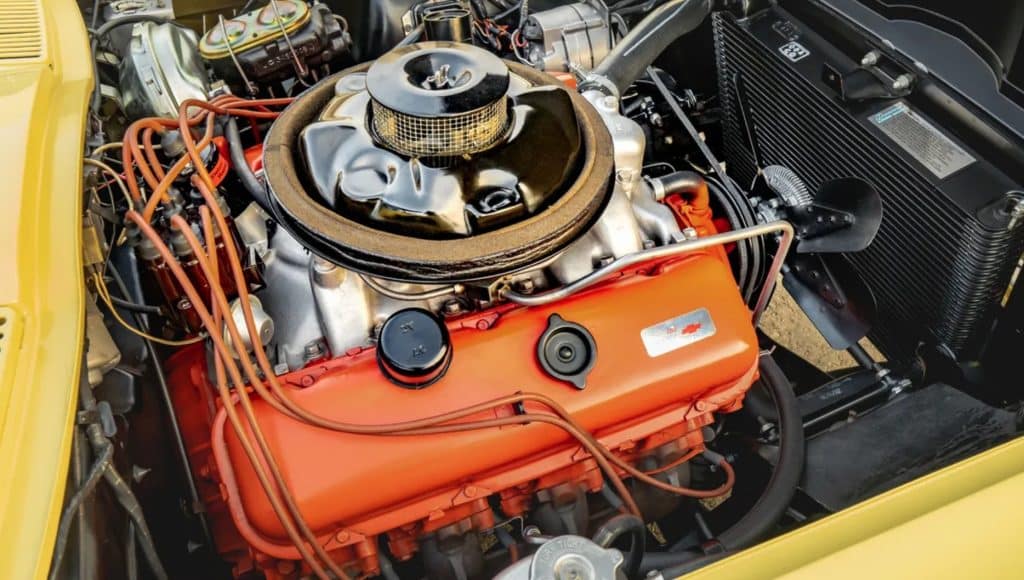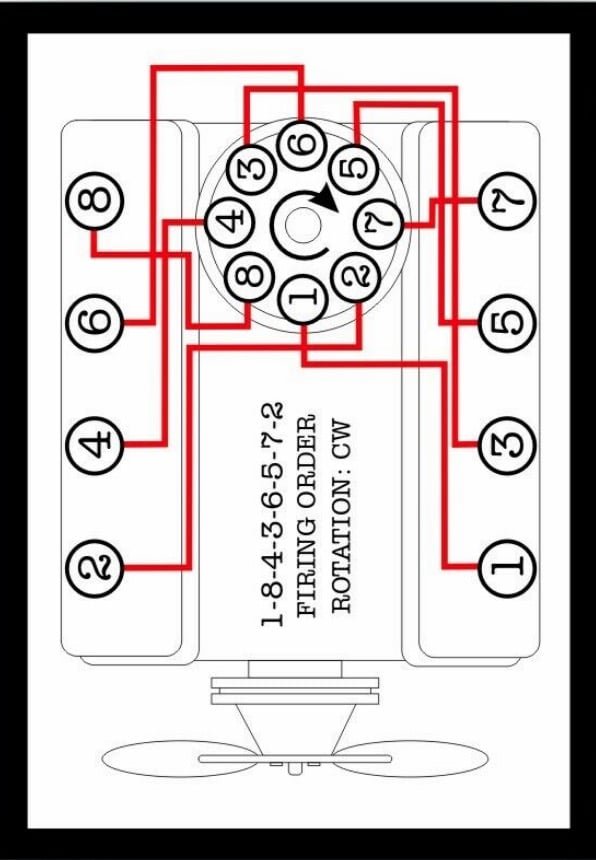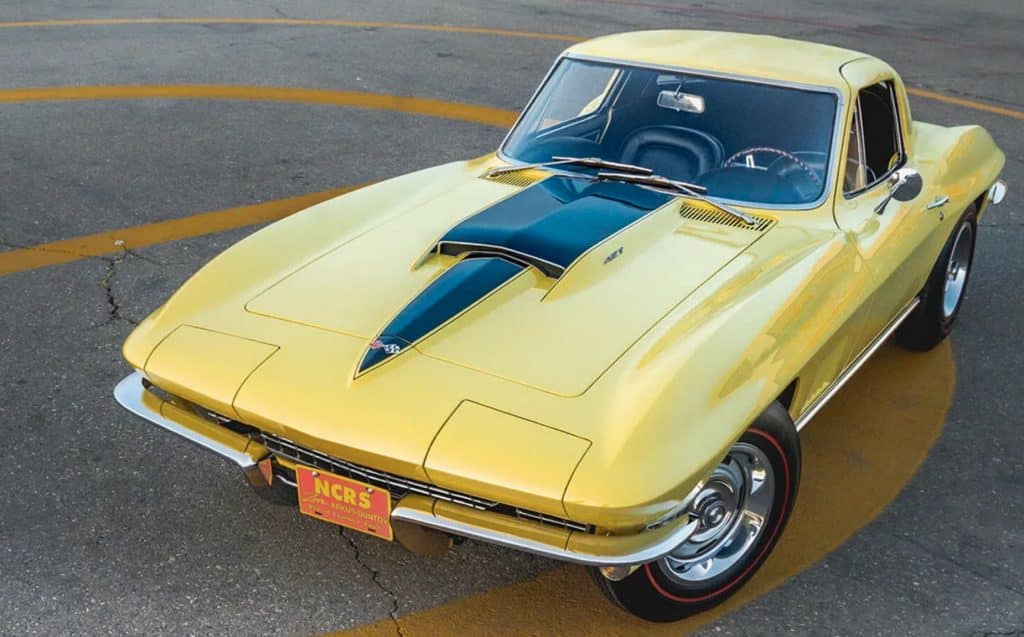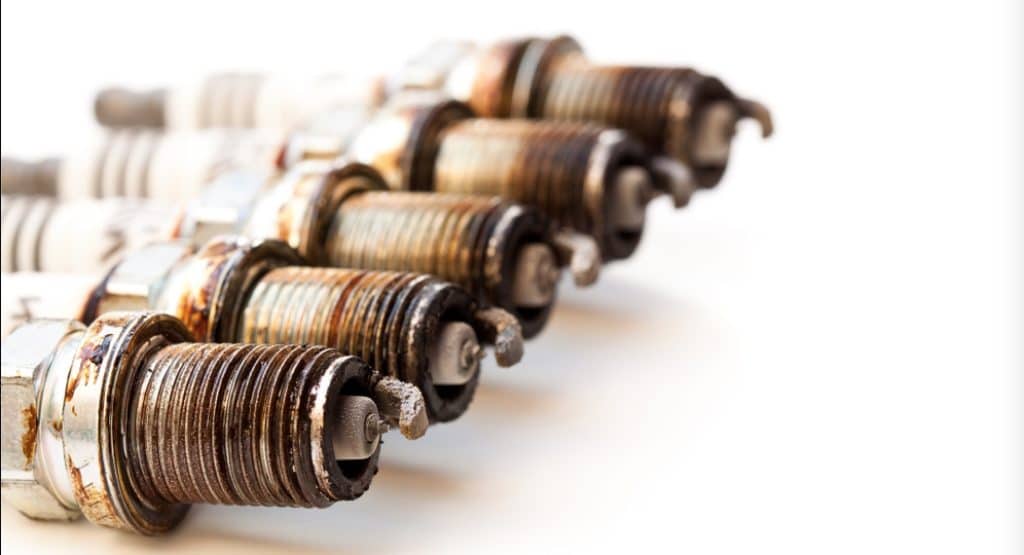Revving up a big block Chevy engine is like unleashing a thunderstorm under the hood. If you’re looking to harness that power, understanding the firing order is crucial.
The standard big block Chevy firing order is 1-8-4-3-6-5-7-2. This sequence ensures your V8 beast purrs like a lion rather than coughing like a kitten.

You might wonder why this particular order matters. Well, it’s all about balance and efficiency.
The right firing sequence keeps your engine running smoothly, reduces vibration, and maximizes power output.
It’s like conducting an orchestra – each cylinder needs to fire at just the right moment for the whole symphony to come together.
Whether you’re working on a classic 396 or a monstrous 454, getting the firing order right is key to unlocking your engine’s full potential.
And let’s face it, there’s nothing quite like the roar of a well-tuned big block Chevy to make your gearhead heart skip a beat.
Key Takeaways
- The firing order ensures optimal engine performance and smoothness
- Proper cylinder firing sequence reduces vibration and maximizes power
- Correct spark plug wire placement is critical for engine reliability
Understanding the Big Block Chevy
You’re about to dive into the world of Chevy’s muscle-making monsters. These powerhouses have left their mark on automotive history, and knowing how to spot one is a skill every gearhead should have.
A Brief History
The big block Chevy V8 roared onto the scene in 1965, flexing its muscles with the 396 cubic inch engine. It was Chevy’s answer to the horsepower wars, and boy, did it deliver!
You might remember the iconic 427, which powered the legendary Corvette. Then came the 454, a true beast that could turn your grocery-getter into a quarter-mile terror.
As the years rolled on, Chevy kept pumping out bigger and badder engines. The 502 became the king of the hill, offering enough grunt to tow your house – if that was legal, of course.
Identifying Your Big Block
So, you’ve popped the hood and you’re staring at a chunk of Detroit iron. Is it a big block? Here’s how to tell:
- Size matters: Big blocks are, well, big. They’re wider and taller than their small block cousins.
- Deck height: Measure from the crank centerline to the block deck. If it’s around 9.8 inches, you’ve got a big block.
- Head bolts: Count ’em. Big blocks have 4 bolts per cylinder, while small blocks have 5.
Look for telltale displacement numbers cast into the block. The 366, 396, 402, 427, 454, and 502 are all members of the big block family.
The Mark IV series (396-502) shares many parts, making them a hot rodder’s dream for swaps and builds. Now go forth and identify those big blocks with confidence!
Diving Into the Firing Order

The big block Chevy firing order is a crucial aspect of engine performance. Understanding this sequence can help you diagnose issues and even boost your engine’s power.
The Magic Sequence Explained
Ever wondered why your big block Chevy purrs like a kitten? It’s all thanks to the firing order 1-8-4-3-6-5-7-2. This sequence isn’t random – it’s engineered for smooth operation.
Picture your engine as a percussion band. Each cylinder is a drummer, and the firing order is their sheet music.
When they hit their beats in perfect harmony, you get that sweet rumble you love.
But what if one drummer misses a beat? That’s when you might hear a misfire or feel a rough idle.
Knowing the firing order helps you pinpoint which “drummer” is out of sync.
Remember, your spark plugs are like the drumsticks. They need to fire in the right order to keep the rhythm going.
If you’re replacing plug wires on your HEI distributor, this sequence is your best friend.
Comparing Small Block vs Big Block Firing Order
You might think small block and big block Chevys march to different beats, but surprise! They actually share the same firing order. It’s like they’re cousins who went to the same music school.
The main difference? Big blocks, like the 396 or 454, have more “drummers” in their band.
They produce more power, but also guzzle more fuel. It’s like having a larger orchestra – more impressive, but also more expensive to run.
Small blocks, such as the 305 or 350, are more compact and fuel-efficient.
They’re like a smaller ensemble – nimble and easier on the wallet.
But here’s a fun fact: some racers tweak the firing order to 1-8-7-3-6-5-4-2. It’s like rearranging the drum solo for a bit more oomph.
You might not need it for your daily driver, but it’s a neat trick to know.
The Nuts and Bolts of Engine Configuration

Understanding the Big Block Chevy’s inner workings is key to mastering its power. Let’s dive into the nitty-gritty of cylinder arrangement and timing to help you grasp what makes this beast tick.
Cylinder Numbering and Orientation
You might think counting cylinders is as easy as 1-2-3, but not so fast, hot rodder! The Big Block Chevy V8 has its own unique way of doing things.
Picture yourself standing at the front of the engine, looking at the belts and pulleys. The left bank is 1-3-5-7, while the right bank is 2-4-6-8.
Cylinder 1 is always at the front of the left bank.
This numbering system is crucial when you’re hooking up those spark plug wires or trying to diagnose a misfire. Get it wrong, and your big block will sound more like a washing machine full of wrenches than a powerhouse.
Timing and Top Dead Center
Now, let’s talk timing – the automotive equivalent of a perfect dance routine.
Top Dead Center (TDC) is where the magic happens. It’s the point where your piston reaches its highest position in the cylinder.
You’ll need to find TDC on cylinder 1 to set your timing correctly.
A handy trick: remove the spark plug, stick your thumb over the hole, and rotate the engine.
When you feel the air pushing against your thumb, you’re close to TDC.
Ensuring Optimal Performance
Getting the most out of your big block Chevy is all about the details. Let’s dive into two key areas that’ll make your engine roar like a lion with a megaphone.
The Role of Spark Plugs

You know those little firecrackers in your engine? Yep, spark plugs. They’re like the conductors of your engine’s orchestra.
For your big block Chevy engine, you’ll want plugs that can handle the heat and pressure.
Go for platinum or iridium plugs. They’re like the superheroes of the spark plug world.
They’ll last longer and give you more consistent performance.
Make sure you gap them right. It’s like giving your engine a perfect haircut.
Too wide, and you’ll miss out on power. Too narrow, and you might as well be trying to light a campfire with a wet match.
Don’t forget to check them regularly. A fouled plug is about as useful as a chocolate teapot.
The Impact of Exhaust Manifolds
Now, let’s talk about your engine’s lungs. The exhaust manifolds are crucial for your big block’s breathing exercises.
You’ve got two choices: headers or cast iron manifolds.
Headers are like giving your engine a pair of running shoes. They’ll help it breathe easier and boost your horsepower.
But don’t discount those old-school cast iron manifolds. They’re like a comfy pair of slippers for your engine. Great for daily drivers and they’ll last forever.
Whichever you choose, make sure they’re matched to your engine’s specs.
Get it right, and you’ll be doing the horsepower tango in no time.
Remember, bigger isn’t always better. You want a good balance of flow and back pressure.
It’s like finding the Goldilocks zone for your exhaust.
Supporting Parts and Maintenance
Keeping your big block Chevy purring like a kitten requires more than just knowing the firing order. You’ll need to keep an eye on key components and perform regular check-ups to ensure your engine stays in top shape.
Key Components to Watch
Your oil pump is the heart of your engine’s lubrication system. Make sure it’s pumping like a champ to keep those pistons sliding smoothly.
Don’t forget about the oil pan – a leak here can leave you high and dry (and your driveway a mess).
The cam sprocket and timing cover work together to keep everything in sync. If they’re off, your firing order might as well be a random number generator.
Your intake manifold and valve cover are like the lungs of your engine. Keep them clean and sealed tight for optimal breathing.
For those of you with automatic transmissions, the flexplate is your best friend. If it’s cracked or warped, you’ll be going nowhere fast.
Routine Check-Up Tips
Start by checking your oil regularly. It’s like a health check for your engine – dark and gritty means it’s time for a change.
Listen for any unusual noises. Your big block should purr, not rattle. If you hear something off, don’t ignore it.
Keep an eye on your temperature gauge. If it’s running hot, you might have a coolant issue or a failing water pump.
Check your belts and hoses. They’re the veins of your engine, and a failure here can leave you stranded.
Don’t forget about your spark plugs. They’re crucial for maintaining that perfect firing sequence.
Lastly, give your centerbolt and bellhousing a once-over now and then. These unsung heroes keep everything aligned and running smooth.
Frequently Asked Questions
Is there a trick to remembering the firing order for a 454 big block?
You bet there is! Think of it as a dance: 1-8-4-3-6-5-7-2.
Just remember, it starts with 1-8, then zigzags back and forth.
Practice saying it out loud a few times, and you’ll have it down pat in no time.
How does the HEI system affect the firing order in a big block Chevy?
The HEI (High Energy Ignition) system doesn’t change the firing order itself.
It just makes the sparks stronger and more reliable.
Your big block will still fire in the same sequence, but with more oomph behind each spark.
Can you explain the advantages of a 4-7 swap in a big block Chevy’s firing order?
The 4-7 swap is like giving your engine a massage. It changes the firing order to 1-8-7-3-6-5-4-2, which can smooth out vibrations and potentially boost power.
Some racers swear by it, claiming it helps their engines breathe better.
Does the firing order differ between a small block and a big block Chevy engine?
Nope, they’re twins in this department! Both small and big block Chevys use the same 1-8-4-3-6-5-7-2 firing order.
It’s like they’re singing the same tune, just with different voices.
What are the symptoms of an incorrect firing order in a Chevy Silverado’s big block?
If your Silverado’s big block has the wrong firing order, it’ll throw a fit.
You might notice rough idling, misfires, backfiring, or a serious lack of power.
It’s like trying to run with your shoes on the wrong feet – it just won’t work right.
How can I visually distinguish the firing order on a Chevy 454 firing order diagram?
On a 454 diagram, you’ll see the cylinders laid out in a V shape.
The driver’s side usually has odd numbers (1-3-5-7), while the passenger side has evens (2-4-6-8).
Follow the lines or arrows connecting the cylinders to see the firing sequence.
